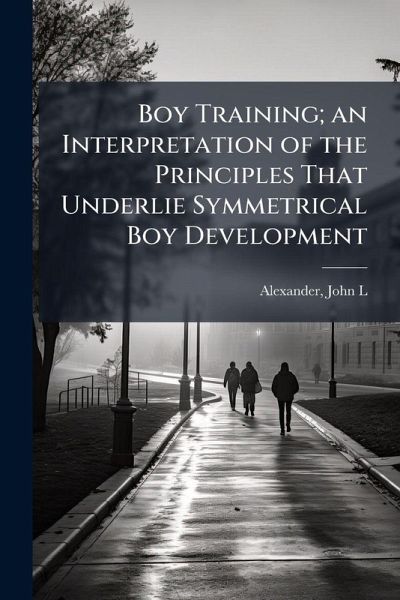
Boy Training; an Interpretation of the Principles That Underlie Symmetrical Boy Development
Versandkostenfrei!
Versandfertig in über 4 Wochen
20,99 €
inkl. MwSt.

PAYBACK Punkte
10 °P sammeln!
"Boy Training; an Interpretation of the Principles That Underlie Symmetrical Boy Development" by John L. Alexander offers a fascinating glimpse into early 20th-century approaches to raising and educating boys. Published in 1915, the book reflects prevailing social and religious values, emphasizing character building, moral development, and physical well-being. Alexander's work provides insights into the pedagogical theories and practical methods employed to shape young men into responsible and virtuous citizens. This volume is of particular interest to those studying the history of education, ...
"Boy Training; an Interpretation of the Principles That Underlie Symmetrical Boy Development" by John L. Alexander offers a fascinating glimpse into early 20th-century approaches to raising and educating boys. Published in 1915, the book reflects prevailing social and religious values, emphasizing character building, moral development, and physical well-being. Alexander's work provides insights into the pedagogical theories and practical methods employed to shape young men into responsible and virtuous citizens. This volume is of particular interest to those studying the history of education, religious studies, and the evolving roles of men in society. It serves as a valuable resource for understanding the historical context of youth development programs and the enduring quest to cultivate positive values in future generations. Alexander's interpretation offers a unique lens through which to examine the cultural ideals and aspirations of a bygone era. This work has been selected by scholars as being culturally important, and is part of the knowledge base of civilization as we know it. This work was reproduced from the original artifact, and remains as true to the original work as possible. Therefore, you will see the original copyright references, library stamps (as most of these works have been housed in our most important libraries around the world), and other notations in the work. This work is in the public domain in the United States of America, and possibly other nations. Within the United States, you may freely copy and distribute this work, as no entity (individual or corporate) has a copyright on the body of the work. As a reproduction of a historical artifact, this work may contain missing or blurred pages, poor pictures, errant marks, etc. Scholars believe, and we concur, that this work is important enough to be preserved, reproduced, and made generally available to the public. We appreciate your support of the preservation process, and thank you for being an important part of keeping this knowledge alive and relevant.












